Consultation methodology and feedback
The consultation discussion document was hosted on MBIE’s ‘Have your say’ page in both PDF and HTML formats.
On this page I tēnei whārangi
MBIE used a stakeholder alert and social media marketing to advertise the opening of the consultation. Social media marketing was used with a ‘one week to go’ message later in the consultation period.
MBIE works closely with the Department of Conservation (DOC) on the management of the IVL, as DOC has responsibility for the Conservation aspect. DOC supported the consultation process through engagement on consultation materials and by releasing its own stakeholder alert announcing its opening.
MBIE hosted 2 public webinars and 2 industry focused online meetings to provide further information on the consultation for interested parties. The first public webinar was recorded and uploaded to MBIE’s website. 113 people attended the public webinars and 15 attended the industry focused events.
Respondents were encouraged to complete a survey, hosted by SurveyMonkey, to provide a response to the questions in the discussion document. Responses were collated by SurveyMonkey and saved in a secure folder on MBIE’s system.
Those who wished to provide additional information alongside or instead of the survey could also send a digital response (such as an email or a long-form response) to MBIE. Respondents could also send mail to MBIE in Wellington.
Responses were collated and assessed by MBIE.
Who submitted
MBIE received a total of 1,101 submissions on the proposed changes to the IVL. 1,011 responses via the online survey, 44 of which were incomplete, and 90 responses via email. 889 respondents submitted as an individual and 212 submitted on behalf of an organisation.
A breakdown of submitter type by category is below.
Table 1: Breakdown of submitter by role
| Submitter role | Count |
|---|---|
| An interested individual | 731 |
| Local Government (or related entity) | 51 |
| Tourism business | 186 |
| Conservation group | 45 |
| Iwi, hapū and Māori organisations | 11 |
| Not-for-profit or club | 47 |
| Other | 74 |
| Total | 1,145 |
Submitters self-identified what category best described their roles (Table 1). Submitters who selected the ‘other’ category were asked to specify their role and responses included: airlines, industry associations, and academics, among others.
Because submitters could select more than one category to describe themselves, there were a total of 1,145 responses from 1,025 submitters who answered this question (Table 1). For example, some submitters selected that ‘an interested individual’ and ‘tourism business’ best described their role(s).
Annex One contains a breakdown of survey responses based on submitter type.
Assessment methodology
MBIE used a searchable spreadsheet to collate and sort responses with the same answers, as most questions in the survey offered fixed value answers.
Free text answers were individually assessed, and similar responses were grouped together to indicate shared perspectives of respondents. Staff assessing free text answers met regularly to ensure each assessor used a similar approach for grouping responses. A similar approach was taken with responses received via email or mail.
Where responses from key industry and community stakeholders were collated, a senior MBIE staff member would review the summary provided by the assessor to ensure accuracy. A peer review was also carried out for all other responses using a random sampling method.
Problem definition
Increasing visitor numbers provide a range of benefits not limited to the tourism sector. However, the current amount of the International Visitor Conservation and Tourism Levy (IVL) is insufficient to address all the costs associated with international tourism. At $35 it does not generate enough funding to support the required level of ongoing investment needed to support communities to address the impacts of international visitors, especially those with low resident to visitor ratios. It also does not address the rising costs of goods and services. The Government believes too much additional funding is being provided from ratepayers and taxpayers.
What we asked
Submitters were asked two questions relating to the current status and use of the IVL.
- Submitters were asked if they agreed that current levels of IVL revenue (approximately $80 million) are not sufficient to address issues facing tourism and conservation.
- Submitters were asked if they agreed that the IVL could be used to address some of the costs for tourism and conservation currently funded by the Crown.
In relation to these questions, submitters were asked to explain their views, including any additional information that would be useful.
What we heard
Most submitters agree that the current IVL revenue is not sufficient
88% of submitters who responded to this question agreed that the current levels of IVL revenue are not sufficient to address the issues facing tourism and conservation. The main reason submitters gave was the need to provide more support for conservation, with just under one third (30%) of responses referencing conservation and a further 13% referencing Department of Conservation (DOC) infrastructure.
Of the responses that mentioned conservation, key themes included: more funding towards estate management (66 submitters), preservation of important areas / maintaining our international drawcard (53 submitters), protecting biodiversity (31 submitters), and supporting pest eradication through Predator Free 2050 and the National Wilding Conifer Control Programme (21 submitters). 29 submitters felt that DOC, and conservation more broadly, is underfunded at present.
“Our already fragile ecosystems need to be managed with care to ensure they remain healthy, not just for future tourism but for the future of Aotearoa and the people who live here … The IVL provides an opportunity to ensure critical funds are still available to support conservation initiatives that underpin our country’s health and growth.” – Conservation group
Other key reasons submitters gave for the levels of IVL revenue not being sufficient included the need to improve and maintain tourism infrastructure (24%), the need to reduce costs for ratepayers and taxpayers (13%), and the need to better support small towns, communities and regions, particularly those that host a high number of international visitors (10%). Submitters also noted that many overseas countries have a variety of visitor charges and the IVL is in line with these.
“We have a beautiful country that we spend plenty of tax payer money to maintain. We should charge the people who come here to see it just like any other attraction the world.” – Individual submitter
“There is insufficient funding within the tourism system to allow the necessary functions to be undertaken to a high standard. This falls across central government, local government and industry domains.” – An organisation
Six per cent of submitters who answered this question felt that the current revenue might be enough or were unsure. These responses referenced that the IVL should not be the only source of funding and that $80 million could be enough revenue depending on how it is spent.
The 6% of submitters who responded no to this question also referenced the current use of the IVL revenue as a reason for their disagreement and the potential impact a change would have on visitor numbers.
Figure 1: Agreement that the current levels of IVL revenue are not sufficient to address issues facing tourism and conservation by submitter type.
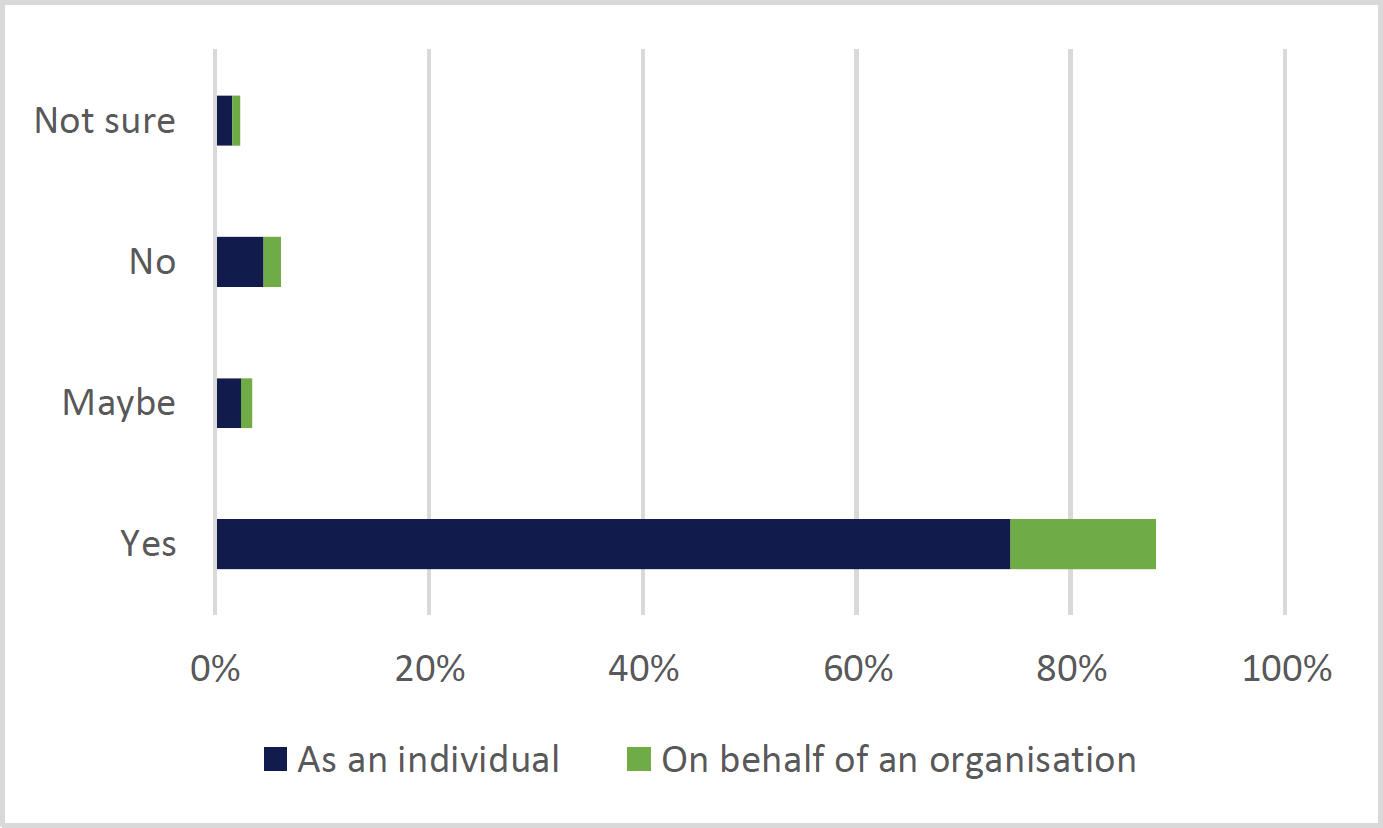
View chart description and data
Submitters agreed that the IVL could be used to address some of the costs currently funded by the Crown
84% of submitters who responded to this question agreed that the IVL could be used to address some of the costs for tourism and conservation that are currently funded by the Crown. While 7% of submitters answered no and 9% responded either maybe or not sure.
Despite the overarching agreement to this question, many responses emphasised that the IVL should be used in addition to Crown funding and should not be used as a replacement (36 submitters). Some submitters raised that the Crown already benefits from the tourism industry both directly (GST paid by international visitors) and indirectly (taxes paid by tourism businesses) and therefore Crown funding on tourism should continue alongside the IVL.
“Yes, the IVL should be used to supplement things that are currently funded by the Crown, but this should be on top of existing funding and not replace it.” – Individual submitter
Figure 2: Agreement that the IVL could be used to address some of the costs for tourism and conservation currently funded by the Crown by submitter type.
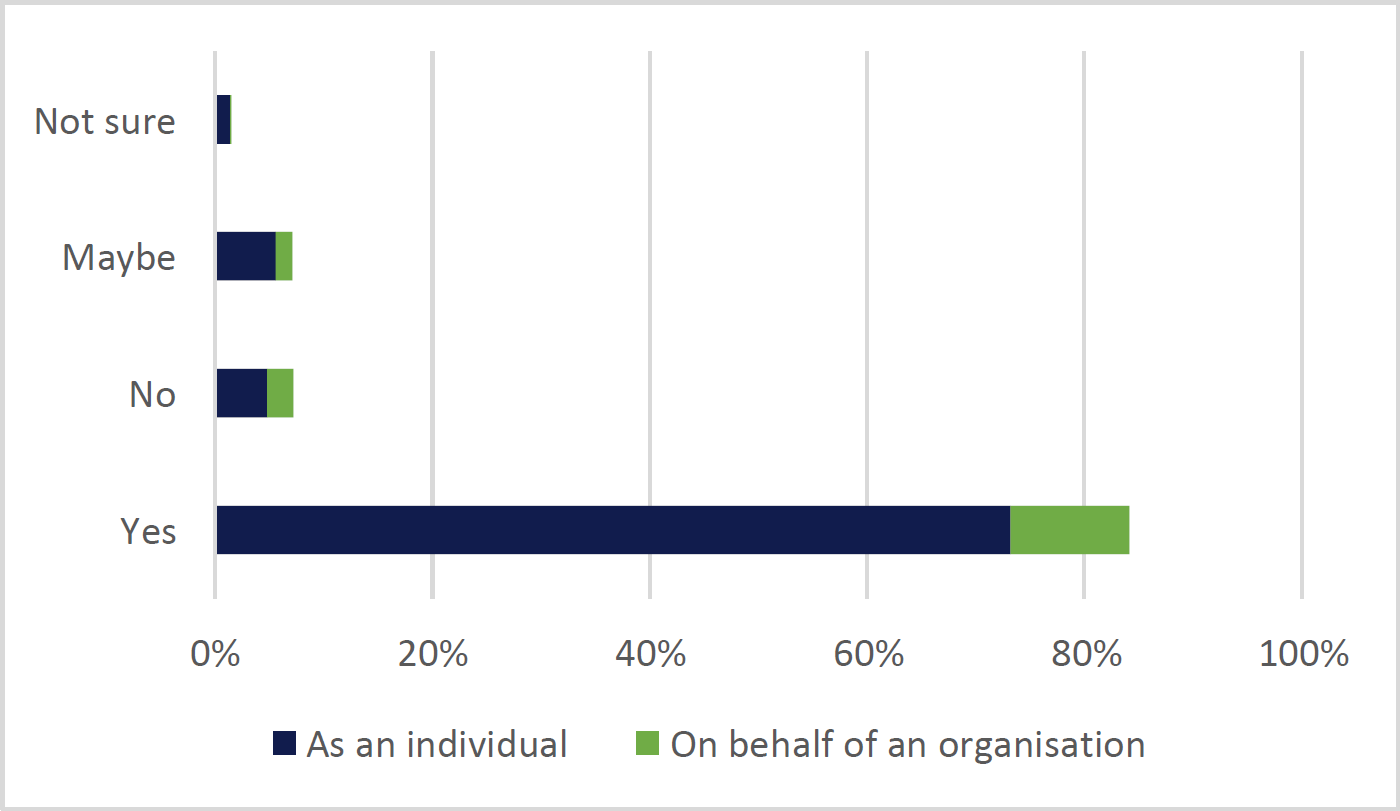
View chart description and data
IVL amount
Most international visitors applying for a visa or a New Zealand Electronic Travel Authority (NZeTA) to enter New Zealand are charged the non-refundable IVL of $35. An NZeTA is valid for two years and is required for visa waiver travellers and Australian permanent residents. Australian citizens, people from many Pacific Island countries , New Zealand citizens and New Zealand visa holders are not required to hold an NZeTA before travelling to New Zealand and therefore are not required to pay the IVL.
Based on the current amount of $35, the IVL is forecast to raise around $80 million per annum. The Government considers that this amount is insufficient to meet the needs of our tourism or conservation sectors as we look to grow tourism to benefit visitors and New Zealanders.
What we asked
Submitters were asked to select their preferred option to address the IVL amount:
- Status quo at $35
- An increase
Submitters were then asked to select their preferred amount for the IVL if it were to increase:
- Increase by $15 to $50
- Increase by $35 to $70
- Increase by $65 to $100
In relation to these questions, submitters were asked to explain their views, including any additional information that would be useful.
What we heard
Submitters strongly support an increase to the IVL
There is strong support for an increase to the IVL amount, with 93% of submitters who responded to this question in support. The main reason individual submitters supported an increase was that they felt that an increase would be reasonable and would put New Zealand in line with other countries’ charges (25%). Submitters raised that international visitors enjoy a multitude of free attractions and amenities while in New Zealand and increasing the IVL would be a good way to support their upkeep.
“The IVL needs to be more than just a token amount - it should be a meaningful and significant contribution to costs incurred on [visitors’] behalf.” – Individual submitter
Other reasons submitters supported an increase were for conservation (18%), tourism infrastructure (14%), and that an increase would be unlikely to impact on visitor numbers and would instead help to attract high value visitors (17%).
“Aotearoa is a high value destination and this is a small amount compared to other costs of travelling here. We need to be realistic about the costs of having international tourists here.” – Individual submitter
Seven per cent of submitters who responded to this question supported maintaining the Status Quo at $35. This included air travel and border organisations such as Air New Zealand, International Air Transport Association, NZ Airports, BARNZ, Auckland Airport, Wellington International Airport, Emirates Airline and New Zealand Cruise Association.
The main reason submitters opposed an increase to the IVL amount was the potential impact it may have on visitation (39%). Submitters raised that there is a lack of elasticity modelling to understand what the potential impact would be, and that New Zealand is already an expensive destination for many. Submitters were concerned that any increase may deter visitors, negatively impacting on the economy.
Another key reason submitters opposed an increase was that they did not feel the IVL is an appropriate tool to address conservation and tourism issues. Some submitters suggested the Government look to introduce more localised tools that are applicable to all visitors, such as an accommodation levy. Finally, some submitters felt that the current IVL amount is sufficient, but it could be spent better to maximise its benefits.
“We do not support an increase until the current IVL process and governance is reviewed and improved. The document lacks modelling to understand the effect of an IVL increase on the propensity to travel to New Zealand. New Zealand is already an expensive destination with numerous fees and levies, along with high on-the-ground costs.” – An organisation
Figure 3: Preferred approach to the IVL amount by submitter type
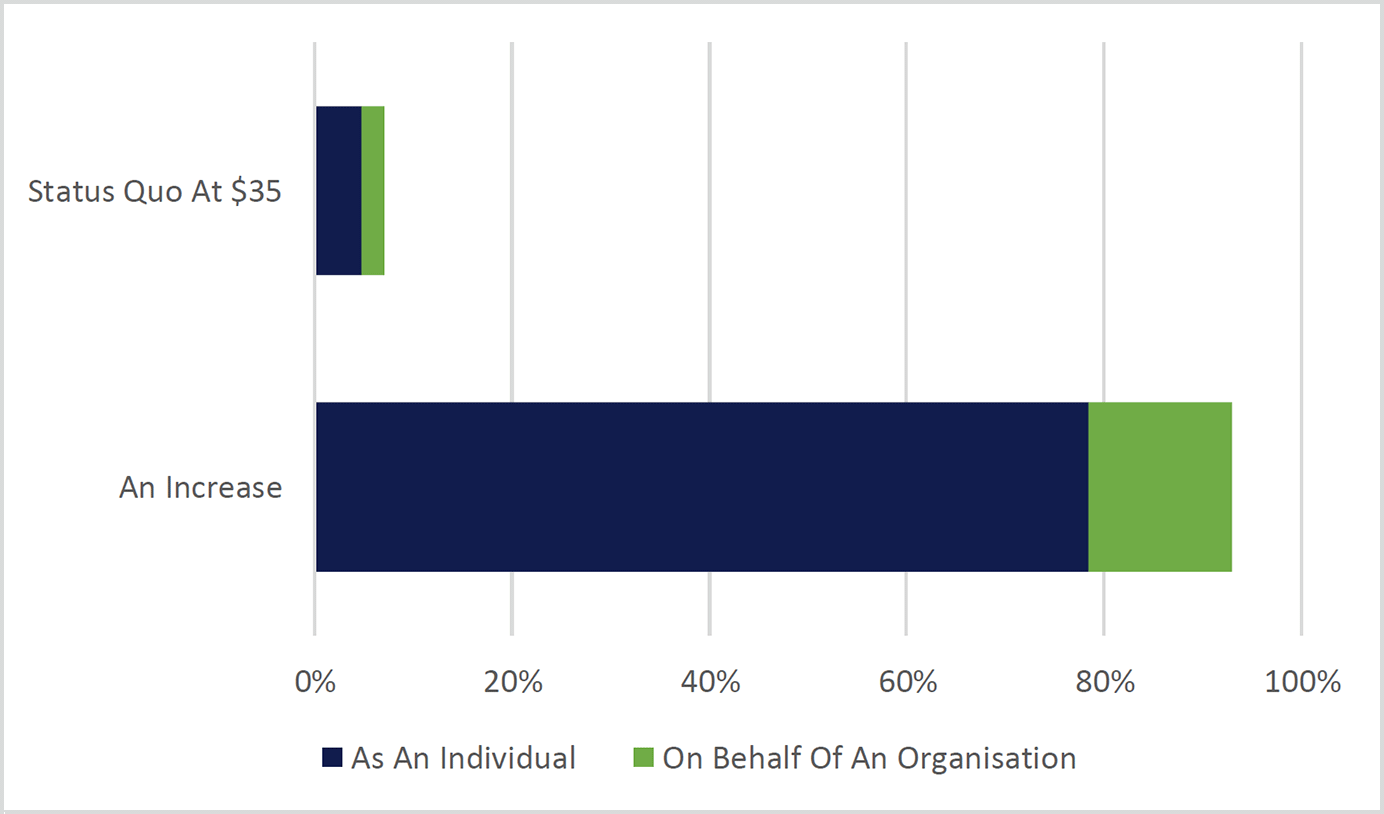
View chart description and data
The majority of sumbitters support $100
Two thirds of submitters who responded to this question selected an increase by $65 to $100 as their preferred option. Those submitters felt this was the most appropriate amount to cover the costs associated with tourism and was reasonable given how expensive New Zealand is to visit. Some submitters felt that $100 was not high enough and suggested instead the IVL be set at $200 or more.
“If people can afford to get to NZ, which is a long way from most of the world, they can afford to offset some of the costs they generate in our infrastructure and environment.” – Individual submitter
Nineteen per cent of submitters who answered this question supported an increase by $35 to $70. Those submitters felt $70 would go a long way to contribute to the costs without deterring visitation.
“I feel this is a significant step forward and I don’t think it will negatively impact tourist businesses.” – Individual submitter
Fifteen per cent of submitters who answered this question supported an increase by $15 to $50. This included tourism organisations such as Tourism Industry Aotearoa, Business Events Industry Aotearoa, Rental Vehicle Association, Holiday Parks New Zealand and a variety of different tourism businesses. These submitters felt this amount would account for inflation but still be accessible for visitors. Responses mentioned that New Zealand is already an expensive destination and given the importance of our backpacker and family markets we need to keep it as affordable as possible. Submitters also raised concerns that, as this is not the only charge international visitors pay when entering the country, the accumulation of rising costs could significantly impact on visitor numbers.
“I agree that costs and inflation are increasing and that the IVL should be increased to reflect these changes, but I worry that too big an increase or a price tag might [aggravate] tourists or deter them from coming.” – Individual submitter
“The proposed increase to the IVL cannot be considered in isolation. It is the overall cost to visitors of crossing the New Zealand border that is the critical metric that needs to be evaluated when considering the proposed changes to the IVL.” - An organisation
Figure 4: Preferred increase to the IVL amount by submitter type
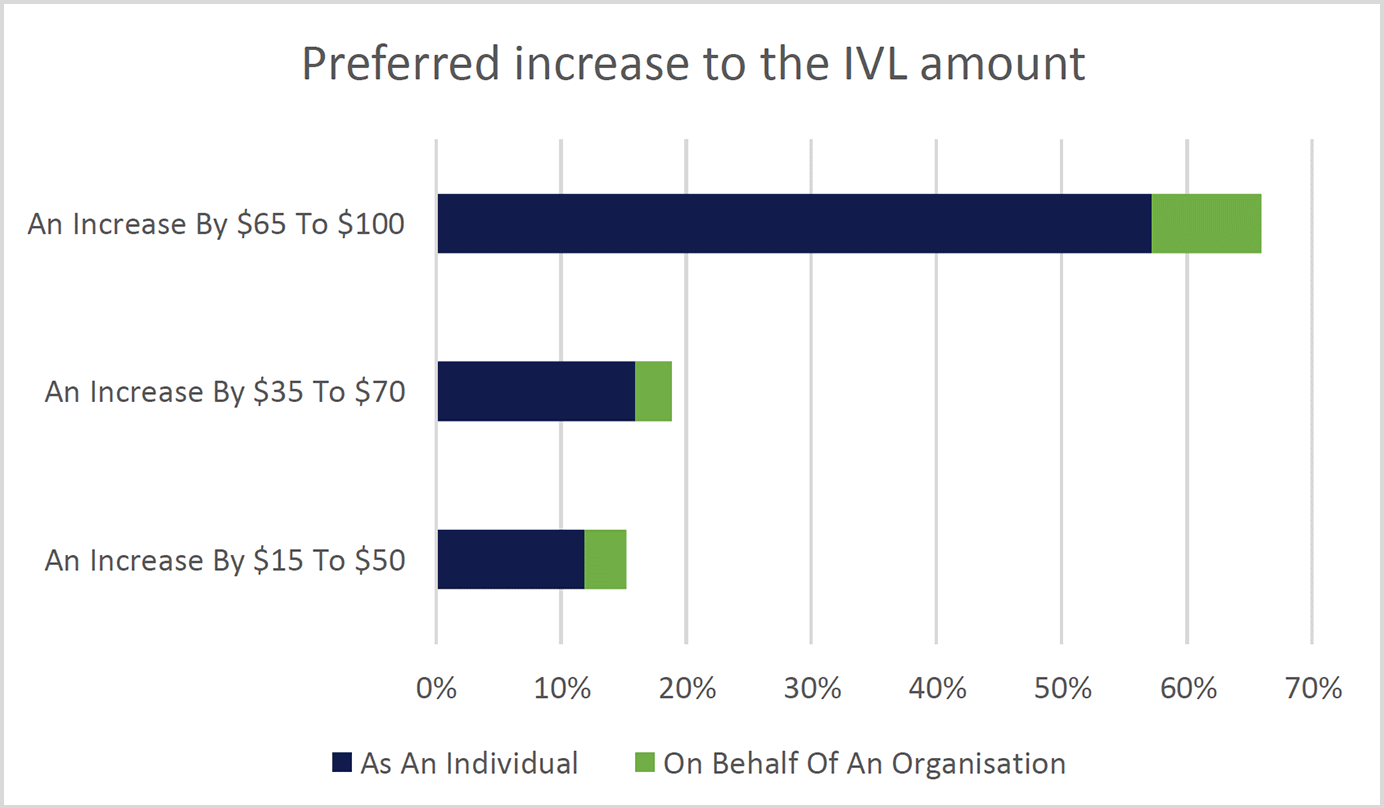
View chart description and data
IVL spending priorities
Funding raised by the IVL is currently split evenly between Conservation and Tourism. This funding is administered by DOC and MBIE, respectively.
Funding from the IVL may be spent on:
- Conservation.
- Infrastructure used for tourism.
- Other initiatives related to tourism.
What we asked
Submitters were asked to indicate their support for IVL revenue to fund the following areas, using a sliding scale of strongly agree to strongly disagree for each:
- Address visitor pressure on mixed-use tourism infrastructure and wider tourism assets.
- Address visitor pressure on the public conservation estate.
- Support investment into ‘club goods’, projects or initiatives that the tourism or conservation sector might benefit from, but are hard for individual businesses to develop or commercialise.
- Contribute to the funding mix for international tourism marketing costs (investment into Tourism New Zealand).
- Support ongoing or future Crown investment into tourism and conservation activities.
- Fund, or contribute to the funding of, other initiatives relating to tourism.
Submitters were also asked if there are any other funding priorities that should be considered.
What we heard
Submitters strongly support using the IVL to address visitor pressure on the public conservation estate and mixed-use tourism infrastructure
Ninety-three per cent of submitters agreed or strongly agreed to the IVL being used to address visitor pressure on the public conservation estate, with approximately one fifth of responses mentioning the need to prioritise conservation spend across different areas such as pest control, DOC infrastructure maintenance, and biodiversity outcomes.
“A key priority for the IVL should be addressing the cost of safeguarding New Zealand’s environment and biodiversity into the future … safeguarding the primary asset that our tourism industry is reliant on …” – Crown entity
There was also considerable support for using the IVL to address visitor pressure on mixed-use tourism infrastructure and wider tourism assets, with 85% of submitters selecting agree or strongly agree. Responses mentioned the need to invest into roading, wastewater, rubbish, toilets, and other public facilities, particularly in communities that have a high visitor to ratepayer ratio.
“IVL funds should be invested in infrastructure and projects which directly improve, and effectively manage, the visitor experience while in Aotearoa New Zealand.” – Local government
Submitters also agreed to the IVL being used to support ongoing or future Crown investment into tourism and conservation activities (60% agree or strongly agree) and to support investment into ‘club goods’, projects or initiatives that the tourism or conservation sector might benefit from but are hard for individual businesses to develop or commercialise (50% agree or strongly agree).
In contrast, there was a strong view that the IVL should not be used to contribute to the funding mix for international tourism marketing costs (investment into Tourism New Zealand). Over half of submitters (53%) disagreed or strongly disagreed, making it the only area that had more opposition than support. Many responses suggested that the tourism sector should pay for its own marketing, or this should be funded by general taxation from central government, while some objected to encouraging more visitors, in general.
“We do not need to spend more to get more tourists here. We already have too many when considering their impact on the New Zealand landscape and lifestyle.” – Individual submitter
Submitters did not feel strongly about the IVL being used to fund, or contribute to the funding of, other initiatives relating to tourism, with over one third of submitters selecting neutral or not sure for this question.
Figure 5: IVL spending priorities
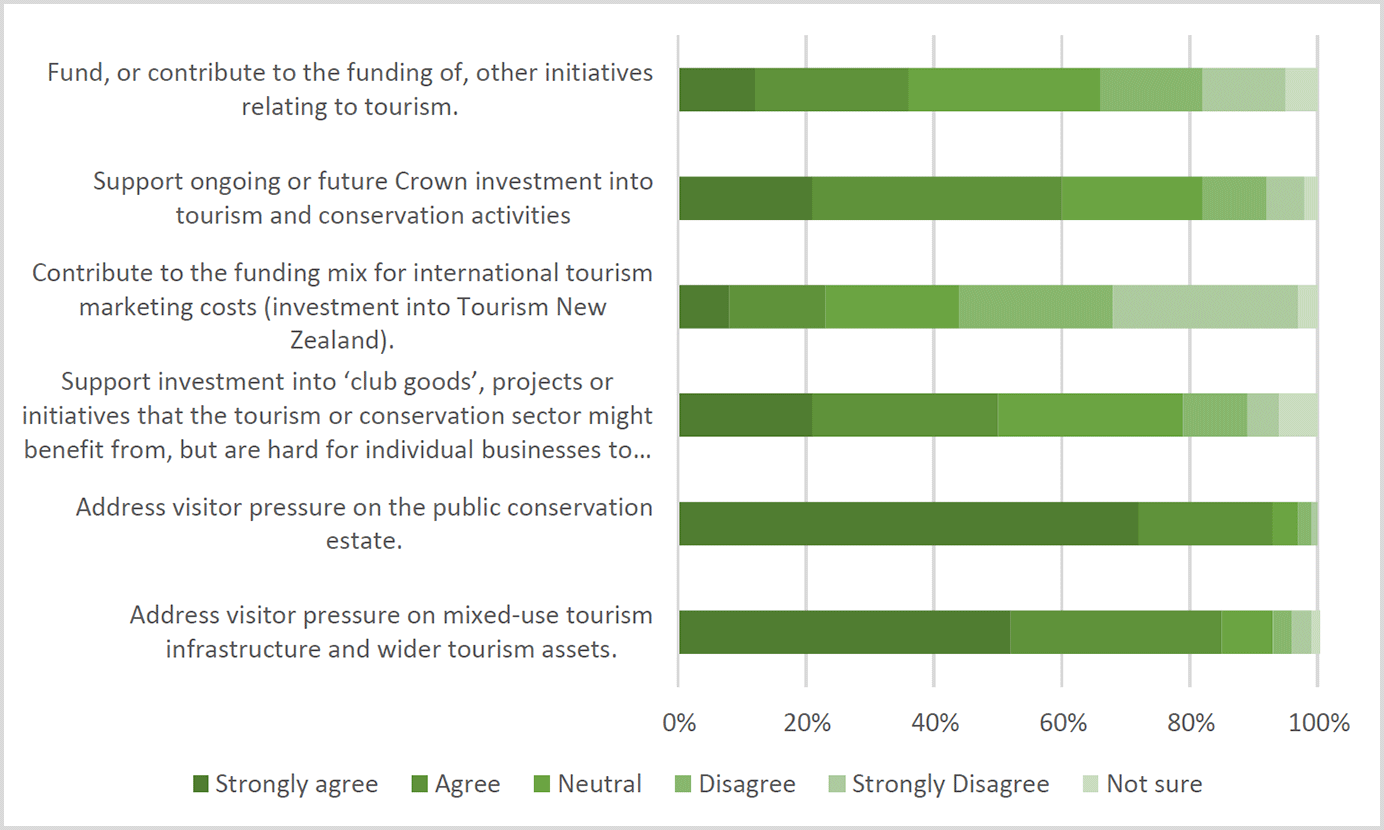
View chart description and data
Submitters identified a range of other funding priorities for the IVL
- Research and development in the tourism sector e.g., research into ideal visitor numbers, the impact of the IVL on visitor decision making, and the development of new recreation facilities (24 submitters)
- Climate change (22 submitters)
- Healthcare costs for visitors (16 submitters)
- More funding for Ngā Haerenga Great Rides (11 submitters)
- Preservation of Māori culture and hertiage / Māori Tourism (8 submitters)
- Search and rescue costs (7 submitters)
- Support for arts, culture and heritage (7 submitters)
- Decarbonisation of aviation e.g., Sustainable Aviation Fuels (6 submitters).
Other feedback received
Submitters raised alternative charges to the IVL
A key theme identified throughout the submissions was the appetite for alternative mechanisms to supplement or replace the IVL.
“Central government needs to consider the ecosystem in its entirety and look at broader mechanisms for generating funding which ensures both national (TNZ) and local (RTOs) bodies can continue to strategically market and manage place.” – Local government
Many submitters raised that New Zealand should look to introduce charging at place, specifically to access National Parks, as these are often under pressure from high visitor volumes. Responses mentioned that these types of charges are common overseas and can be directly invested back into park maintenance. Other submitters raised that some type of an accommodation charge could be introduced.
Submitters want greater transparency on where IVL funding goes
Some submitters raised the need for greater transparency on where IVL funding is spent and improved governance, suggesting that linking the IVL spending to tangible outcomes, such as conservation projects, would help visitors understand and appreciate why they pay it.
“Communicated well, [the IVL] could inspire positive visitor behaviour across their time in NZ and extend the impact beyond whatever the fee is. Aligning it with Tiaki - Care for New Zealand would be a good opportunity for this.” – Individual submitter
Next steps
What happens next?
The responses to this consultation will be used to inform advice to the Minister for Tourism and Hospitality, the Minister of Conservation, and the Minister of Finance regarding possible changes to the operation of the International Visitor Conservation and Tourism Levy.

